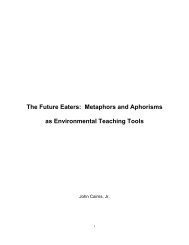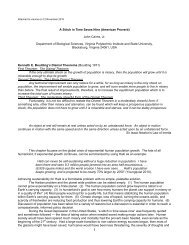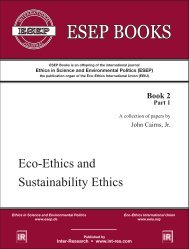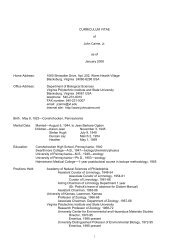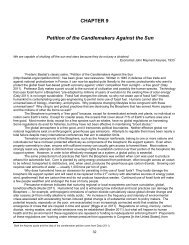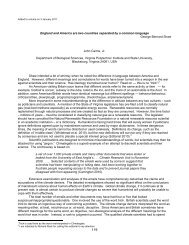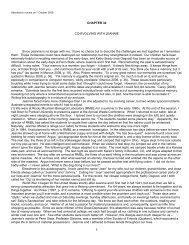Destroying Paradise - Professor John Cairns, Jr.
Destroying Paradise - Professor John Cairns, Jr.
Destroying Paradise - Professor John Cairns, Jr.
You also want an ePaper? Increase the reach of your titles
YUMPU automatically turns print PDFs into web optimized ePapers that Google loves.
Asian J. Exp. Sci., Vol. 22, No. 3, 2008; 177-181<br />
<strong>Destroying</strong> <strong>Paradise</strong><br />
<strong>John</strong> <strong>Cairns</strong>, <strong>Jr</strong>.<br />
Department of Biological Sciences,<br />
Virginia Polytechnic Institute and State University,<br />
Blacksburg, Virginia 24061, USA<br />
Abstract : The day will probably come when descendants of the human race will look back at<br />
the planet their ancestors lived on and view it as a paradise compared to the hostile, alien<br />
planet they will inhabit then. The genus Homo has been on the planet for about two million<br />
years and Homo sapiens for about 160,000 years. Both existed as a small group species spread<br />
thinly over Earth. In the last two centuries, explosive population growth has occurred in Homo<br />
sapiens, far exceeding Earth's carrying capacity (i.e., ecological overshoot). The human<br />
population in 2008 is approximately 6.6 billion and is still growing at about 1.5 million individuals<br />
each week. This growth in population has been made possible by fossil fuel, which fostered<br />
technological development that enabled extraction of natural resources much more rapidly than<br />
Earth could regenerate them. The Agricultural Revolution provided abundant food, partly<br />
because of domestication of plants and animals and partly because of the development of<br />
agribusiness based on abundant, cheap energy. The belief in perpetual economic growth was<br />
based on the assumption that depletion of a resource was not a crucial problem because human<br />
ingenuity and creativity would always provide a substitute. Economic growth almost always<br />
took precedence over preservation of the biospheric life support system, which maintains<br />
conditions favorable to Homo sapiens. Anyone who thinks these trends can continue on a<br />
finite planet is delusional. Global climate change (e.g., droughts, disease transmission, melting<br />
glaciers) has already caused hardship in many different geographic locations on the planet.<br />
The present era is clearly an evolutionarily defining one for the human species, but, the<br />
precautionary measures currently being undertaken are not congruent with the scale of the<br />
problem.<br />
Key words : Posterity, Carrying capacity, Ecological overshoot, Economic growth,<br />
Overpopulation, Resource depletion, Sustainability, Klimakatastrophe.<br />
More than any other time in<br />
history, mankind faces a crossroads.<br />
One path leads to despair and utter<br />
hopelessness. The other to total<br />
extinction. Let us pray we have the<br />
wisdom to choose correctly.<br />
Woody Allen<br />
He who refuses to learn deserves<br />
extinction.<br />
Rabbi Hillel<br />
What I really wanted was to travel<br />
and see all the different animals that<br />
were on the verge of extinction.<br />
Leonardo DiCaprio<br />
Birth and death are so closely<br />
related that one could not destroy<br />
either without destroying the other at<br />
the same time. It is extinction that<br />
makes creation possible.<br />
Samuel Butler<br />
The extinction of the human<br />
species may not only be inevitable,<br />
but a good thing . . .<br />
Editorial, The Economist, 28 December<br />
1988<br />
The concept of sustainable use of the<br />
planet is based on the assumption that humans<br />
could, if they lived within Earth’s carrying<br />
capacity, remain indefinitely. Since estimates<br />
177
<strong>Cairns</strong> <strong>Jr</strong>., J. (2008) Asian J. Exp. Sci., 22(3), 177-181<br />
indicate that the sun will last billions of years<br />
before it dies, the idea of an indefinite time<br />
span for human existence is extraordinary. A<br />
more realistic time span would be that of the<br />
horseshoe crab, which has already lasted<br />
almost half a billion years. Surely Homo<br />
sapiens should be able to match this existence<br />
record! However, a reasonable question to<br />
ask is why, given the present rate of habitat<br />
destruction, this time span might even be<br />
possible for humankind.<br />
Over a decade ago, I believed that<br />
sustainable use of the planet was justified for<br />
humans if they established a harmonious<br />
relationship with natural systems and protected<br />
the ecological integrity of those systems<br />
(<strong>Cairns</strong>, 1994). In the present state of<br />
ecological disequilibrium due to climate change<br />
and other factors, such as peak oil,<br />
overpopulation, and ecological overshoot, the<br />
quest for sustainability should be replaced with<br />
a quest for human survival (<strong>Cairns</strong>, 2007).<br />
After a few centuries of ecological<br />
disequilibrium, a new state of dynamic<br />
equilibrium may allow a renewal of the quest<br />
for sustainable use of the planet.<br />
Developing an Ecolate Perspective<br />
Hardin (1980) notes an unknown person’s<br />
assertion that literacy is not all that is needed<br />
to understand ecological systems, but that<br />
numeracy, the ability to handle numbers, is also<br />
needed. Hardin (other related Hardin<br />
publications are listed in <strong>Cairns</strong>, 2005) also adds<br />
a third level of education – the level of ecolacy,<br />
defined as the level at which a person achieves<br />
a working understanding of the complexity of<br />
the world, of the ways in which each quasistable<br />
state gives way to other quasi-stable<br />
states as time passes. Hardin believes that<br />
these three levels of education can be<br />
epitomized by the following questions: (1)<br />
literacy – what is the appropriate word? (2)<br />
numeracy – how much/how many? (3) ecolacy<br />
– and what then? Hardin concludes that the<br />
basic insight of the ecolate citizen is that the<br />
world is a complex of systems so intricately<br />
interconnected that one can seldom be very<br />
confident that a proposed intervention in this<br />
system of systems will produce the desired<br />
consequences. Since the time of Hardin’s<br />
conclusions in 1980, environmental problems<br />
have increased so rapidly that the planet is in<br />
imminent peril. Literacy has not kept pace<br />
with the rate of problem development.<br />
Numeracy may have declined in the public<br />
domain, but has improved in scientific<br />
documents such as the Intergovernmental<br />
Panel on Climate Change reports. Ecolacy<br />
may have improved in the scientific community,<br />
but not nearly enough in either the political<br />
realm or the general public, who must make<br />
crucial decisions on such areas as massive<br />
reductions in greenhouse gas emissions.<br />
The Global Commons<br />
In Hardin’s frequently cited and reprinted<br />
paper “The Tragedy of the Commons” (Hardin,<br />
1968), he asserts that human suffering would<br />
increase if humankind fails to recognize that<br />
the planet and its resources are finite. In<br />
addition, Hardin remarks that humankind does<br />
not have the right to consume resources in<br />
ways that would adversely affect posterity. His<br />
views were prophetic, and, despite wide citation<br />
and distribution of Hardin’s paper and his<br />
academic stature (he was a member of the<br />
American Philosophical Society and received<br />
many honors), little has been done in heeding<br />
his call to manage the global commons. As a<br />
consequence, both the global atmosphere and<br />
the world’s oceans are in a deplorable condition,<br />
which, if present trends continue, will threaten<br />
human society and even human survival.<br />
Population Crisis<br />
Ehrlich and Ehrlich (2008) sums up<br />
humankind’s present situation on population<br />
superbly: “the projected 2.5 billion further<br />
increase in the human population will almost<br />
certainly have a much greater environmental<br />
impact than the last 2.5 billion added since<br />
178
<strong>Destroying</strong> <strong>Paradise</strong><br />
1975.” The “easy” petroleum has already been<br />
used, and consumption is now coming from<br />
the “tough” petroleum era. Ehrlich and Ehrlich<br />
(2008) further notes:<br />
To support the newcomers, metals<br />
will have to be won from ever-poorer<br />
ores, while oil, natural gas, and water<br />
will need to be obtained from everdeeper<br />
wells and transported further.<br />
So-called “marginal” lands, often the<br />
last strongholds of biodiversity on which<br />
we all depend for essential ecosystem<br />
services, increasingly will be converted<br />
into yet more crops to feed people,<br />
livestock, or (as biofuels) SUVs.<br />
Ehrlich concludes that ending population<br />
increase is not enough – the population must<br />
be reduced.<br />
Klimakatastrophe<br />
Klimakatastrophe was Germany’s 2007<br />
word of the year (Kirschbaum, 2007) – it<br />
confers a sense of urgency lacking in the cozy<br />
term global warming or even James<br />
Lovelock’s more descriptive term global<br />
heating. Greenhouse gas emissions are<br />
increasing. For example, the growth in China’s<br />
emissions of carbon dioxide is far greater than<br />
previous estimates (ENS, 2008). This situation<br />
is made even more critical by China’s doubt<br />
about reaching its stated environmental goals<br />
(Staff Writers, 2008).<br />
The probability of catastrophes caused by<br />
climate change is increased by “threat<br />
multipliers.” For example, in an effort to<br />
decrease American dependence on foreign oil,<br />
which is a definite threat to economic security,<br />
US President George Bush supported goals of<br />
producing large amounts of ethanol as<br />
automotive fuel, especially if it were derived<br />
from corn. However, this approach threatens<br />
food prices, especially for poor people in<br />
Mexico where a food staple, tortillas, is made<br />
from corn. Since corn is also an important<br />
livestock food, diverting corn to ethanol<br />
production also raises prices for meat and eggs.<br />
Since farmers have switched from wheat and<br />
other grains to corn, which appeared more<br />
profitable with its new found uses, other grains<br />
have become scarce and, therefore, prices are<br />
rising for the remaining grains. Since<br />
approximately 800,000 people go to bed hungry<br />
nightly and live on approximately $US1 per day,<br />
high prices for grains exacerbate an already<br />
precarious situation. Finally, as grain prices<br />
rise, farmers will be tempted to use fallow,<br />
marginal agricultural land for grain production.<br />
This fallow land serves as a habitat for a variety<br />
of plants and animals that provide some<br />
ecosystem services and, thus, are part of Earth’s<br />
biospheric life support system.<br />
The Australians may have already<br />
experienced the “new” climate, an adjustment<br />
that humankind will face everywhere, although<br />
circumstances will vary (BBC News, 2008).<br />
Australia is normally the second largest exporter<br />
of grain in the world (The United States is first)<br />
and, in a good year, would hope to harvest 25<br />
million tons. Global wheat stocks are at their<br />
lowest levels since 1979, and the ongoing<br />
Australian drought is one of the reasons why.<br />
Other occurrences give greater cause for<br />
concern. Oceans cover 70% of Earth’s<br />
surface (360 million square kilometers) and less<br />
than 4% remains unaffected by human impact<br />
(Biello, 2008). Worse yet, more than one-third<br />
has suffered serious human impacts, such as<br />
overfishing, fertilizer runoff, pollution, shipping,<br />
and climate change. In addition, oceans have<br />
been a major sink for carbon dioxide, but<br />
acidification will affect marine life and warming<br />
of surface waters will decrease carbon dioxide<br />
absorption. Despite the magnitude of the<br />
problem and abundant scientific studies<br />
documenting ocean changes, no substantial<br />
efforts are being made by world governments<br />
and other institutions to do something about it<br />
(Editorial, 2008).<br />
The failure to protect posterity (stated<br />
more bluntly – one’s children, grandchildren,<br />
179
<strong>Cairns</strong> <strong>Jr</strong>., J. (2008) Asian J. Exp. Sci., 22(3), 177-181<br />
and great grandchildren) is an issue about<br />
which humankind is in denial. Scientists agree<br />
that time for debate is short (Porter, 2008).<br />
Climate change could start causing irreparable<br />
damage in the not-too-distant future, or perhaps<br />
it is already occurring. Porter (2008) states:<br />
Assuming our grandchildren’s<br />
welfare is just as valuable as our own<br />
provides a metric to measure the value<br />
of investments for the future: devoting<br />
X percent of the current generation’s<br />
income to forestall global warming<br />
would be a good deal if it produced a<br />
benefit amounting to more than X<br />
percent of the future generation’s<br />
income.<br />
Conclusions<br />
For approximately two million years,<br />
Earth’s biospheric life support system (BLSS)<br />
has maintained conditions favorable to the<br />
genus Homo. The BLSS was not intentionally<br />
supporting the genus Homo – the favorable<br />
conditions just happened and remained in a<br />
dynamic (i.e., actively changing) equilibrium<br />
until the most recent species of the genus<br />
Homo, Homo sapiens, discovered fossil fuel<br />
and developed technology to take advantage<br />
of the new, cheap, abundant source of energy.<br />
Earth may not have seemed like a paradise in<br />
the past, but it will in retrospect when climate<br />
change produces conditions alien to<br />
humankind’s experience. Australia is already<br />
beginning to experience some of these less<br />
favorable conditions, as are other parts of the<br />
planet, such as low lying Pacific islands.<br />
Despite the preponderance of scientific<br />
evidence, humankind is continuing practices<br />
that are destroying paradise. Why is that?<br />
Hardin’s (1980) statement nearly three<br />
decades ago appears to have been prophetic<br />
and essential to a working understanding of<br />
the complexity of the world. Little has changed<br />
since Hardin’s insightful analysis was published,<br />
as the following illustrative examples show.<br />
(1) literacy – in the United States,<br />
bureaucratic doubt surrounds listing the polar<br />
bear as an endangered species, although its<br />
habitat (polar ice) is shrinking at an alarming<br />
rate.<br />
(2) numeracy – the Intergovernmental<br />
Panel on Climate Change reports are replete<br />
with numerical data, yet one US senator<br />
persists in denouncing global heating as a hoax<br />
perpetuated by scientists.<br />
(3) ecolacy – ethanol was touted as a way<br />
to end US dependence on foreign oil.<br />
However, just producing a tiny amount of<br />
ethanol from corn of the total needed to<br />
replace gasoline has sent grain prices soaring.<br />
Two examples from the economic system<br />
also indicate that little has changed as the result<br />
of ecological experiences.<br />
(1) A common economic statement is: “A<br />
rising tide lifts all boats.” However,<br />
metaphorically speaking, the luxury yachts are<br />
clearly lifted while the more plebian rowboats<br />
are grounded. Kranz (2008) reports: “Despite<br />
fear of an economic recession and unrelenting<br />
job pressures among those who remain<br />
yachtless, there’s still a lot of money floating<br />
around the world. And as the superrich get<br />
richer, the size of yachts grows bigger and<br />
bigger, too.” Estimates are that a yacht that is<br />
328 feet long would cost about US$230 million<br />
today, with prices rising to US$650 million for<br />
a 500-foot yacht.<br />
(2) Meanwhile at the other end of the<br />
economic spectrum, tours of houses in<br />
Traverse City, Michigan, USA, had a common<br />
trait: foreclosure (Saulny, 2008). The agent<br />
for the tour stated that she had so many<br />
repossessed properties in her listings that the<br />
most efficient way to transport potential<br />
purchasers to the houses was to rent a bus<br />
and show all the houses as a group.<br />
Foreclosures are by no means restricted to this<br />
one state; they are common in much of the<br />
United States (Leinberger, 2008). For the<br />
180
<strong>Destroying</strong> <strong>Paradise</strong><br />
average American family, owning a home is<br />
the major financial investment; consequently,<br />
these events make families feel insecure and<br />
troubled at the very least.<br />
Meanwhile, Earth, home to Homo<br />
sapiens, is in imminent peril, which will<br />
adversely affect not only humans but millions<br />
of other species as well. A habitable planet<br />
will, if lost, be seen in retrospect like paradise.<br />
Acknowledgements<br />
I am indebted to Darla Donald for<br />
transcribing the handwritten draft of this article<br />
and editorial assistance in the subsequent drafts<br />
and to Paul Ehrlich, Karen <strong>Cairns</strong>, and Paula<br />
Kullberg for calling useful references to my<br />
attention.<br />
References<br />
BBC News (2008): Australia's food bowl lies<br />
empty. 11Mar http://news.bbc.co.uk/2/hi/asiapacific/7289194.stm.<br />
Biello D. (2008): Ocean impact map reveals human<br />
reach global. Scientific American 15Feb http://<br />
www.sciam.com/article.cfm?id=ocean-impactmap.<br />
<strong>Cairns</strong> J. <strong>Jr</strong>. (1994): Ecological restoration: reexamining<br />
human society's relationship with<br />
natural systems. The Abel Wolman<br />
Distinguished Lecture. National Academy of<br />
Sciences Press, Washington, DC. Also<br />
available online at www.johncairns.net under<br />
"Archives - Article 2" in "Goals and<br />
Conditions for a Sustainable World."<br />
<strong>Cairns</strong> J. <strong>Jr</strong>. (2005): Biographical memoirs - Garrett<br />
Hardin. Proc. Am. Phil. Soc. 149(3):413-419.<br />
Also available online at www.johncairns.net<br />
under "Current Papers."<br />
<strong>Cairns</strong> J. <strong>Jr</strong>. (2007) Postponing the quest for<br />
sustainability: survival first - then<br />
sustainability. Chapter 25 in My Quest for<br />
Sustainable Use of the Planet. Online at<br />
www.johncairns.net.<br />
Editorial (2008): Oceans at risk. New York Times<br />
9Mar http://www.nytimes.com/2008/03/09/<br />
opinion/09sun2.html?ref=todayspaper.<br />
Ehrlich P. R. and Ehrlich A. H. (2008): Letters: The<br />
biggest menace? New York Review LV(2):58.<br />
ENS (2008): Growth in China's CO2 emissions<br />
double previous estimates. Environmental<br />
News Service 11Mar http://www.ensnewswire.com/ens/mar2008/2008-03-11-01.asp.<br />
Hardin G. (1968): The tragedy of the commons.<br />
Science 162:1243-1248.<br />
Hardin G. (1980): An ecolate view of the human<br />
predicament. In C. N. McRostie, ed. Global<br />
Resources: Perspectives and alternatives: XIV<br />
Nobel Conference. University Park Press,<br />
Baltimore, MD.<br />
Kirschbaum E. (2007): "Klimakatastrophe" picked<br />
as Germany's word of the year. Reuters 7Dec<br />
http://blogs.reuters.com/environment/2007/12/<br />
07/klimakatastrophe-picked-as-germanysword-of-year/.<br />
Kranz P. (2008): Measuring wealth by the foot.<br />
New York Times 16Mar http://<br />
www.nytimes.com/2008/03/16/business/<br />
16drop.html.<br />
Leinberger C. B. (2008): The next slum? The<br />
Atlantic 301(2):70-75.<br />
Porter E. (2008): Are the grandkids worth the<br />
money? New York Times 14Mar http://<br />
www.nytimes.com/2008/03/14/opinion/<br />
14fri4.html.<br />
Saulny S. (2008): A tour for the times, seeking deals<br />
among the repossessed. New York Times<br />
16Mar http://www.nytimes.com/2008/03/16/us/<br />
16repo.html.<br />
Staff Writers (2008) China casts doubt on reaching<br />
environmental goals. 11Mar http://<br />
www.terradaily.com/reports/<br />
China_casts_doubt_on_reaching_environment_<br />
goals_999.html.<br />
181
<strong>John</strong> <strong>Cairns</strong>, <strong>Jr</strong>.<br />
University Distinguished <strong>Professor</strong> of Environmental Biology Emeritus and Director Emeritus,<br />
University Center for Environmental and Hazardous Materials Studies<br />
Department of Biological Sciences<br />
Virginia Polytechnic Institute and State University<br />
Blacksburg, Virginia 24061 USA<br />
Telephone: 540-231-8010 (office), 540-951-2799 (home)<br />
Fax: 540-231-9307; Email: jcairns@vt.edu<br />
<strong>Cairns</strong> received the PhD and MS from the University of Pennsylvania, an AB from Swarthmore College and<br />
completed a postdoctoral course in isotope methodology at Hahnemann Medical College, Philadelphia. He was<br />
Curator of Limnology at the Academy of Natural Sciences of Philadelphia for 18 years and has taught at various<br />
universities and field stations. Professional certifications include Qualified Fishery Administrator by the American<br />
Fisheries Society, Senior Ecologist by the Ecological Society of America, and the Academy of Board Certified<br />
Environmental Professionals.<br />
Among his honors are Member, National Academy of Sciences; Member, American Philosophical Society; Fellow,<br />
American Academy of Arts and Sciences; Fellow, American Association for the Advancement of Science; Foreign<br />
Member, Linnean Society of London; Founder's Award of the Society for Environmental Toxicology and Chemistry;<br />
United Nations Environmental Programme Medal; Fellow, Association for Women in Science; U.S. Presidential<br />
Commendation for Environmental Activities; Icko Iben Award for Interdisciplinary Activities from the American Water<br />
Resources Association; Phi Beta Kappa; B. Y. Morrison Medal (awarded at the Pacific Rim Conference of the<br />
American Chemical Society); Distinguished Scientist Award, American Institute of Biological Sciences; Superior<br />
Achievement Award, U. S. Environmental Protection Agency; Charles B. Dudley Award for excellence in publications<br />
from the American Society for Testing and Materials; Life Achievement Award in Science from the Commonwealth of<br />
Virginia and the Science Museum of Virginia; American Fisheries Society Award of Excellence; Doctor of Science,<br />
State University of New York at Binghamton; Fellow, Virginia Academy of Sciences; Fellow, Eco-Ethics International<br />
Union; Twentieth Century Distinguished Service Award, Ninth Lukacs Symposium; 2001 Ruth Patrick Award for<br />
Environmental Problem Solving, American Society of Limnology and Oceanography; 2001 Sustained Achievement<br />
Award, Renewable Natural Resources Foundation; Morrill Chapter, Alpha Zeta, Class of 1944 as of 13 March 2002.<br />
<strong>Cairns</strong> has served as both vice president and president of the American Microscopical Society; has served on 18<br />
National Research Council committees, two as chair; is presently serving on 14 editorial boards; and has served on<br />
the Science Advisory Board of the International Joint Commission (U.S. and Canada) and on the USEPA Science<br />
Advisory Board. The most recent of his 63 books are My Quest for Sustainable Use of the Planet, 2005; Eco-<br />
Ethics and Sustainability Ethics, Book 2, Part 2, 2004; Handbook of Ecotoxicology, Second Edition, 2003;<br />
Ecological and Sustainability Ethics, 2003; Eco-Ethics and Sustainability Ethics, Book 2, Part 1, 2003: Goals<br />
and Conditions for a Sustainable Planet, 2002; Japanese edition of Restoration of Aquatic Ecosystems:<br />
Science, Technology, and Public Policy, 1999<br />
Service on National Research Council (the operating arm of the National Academy of Sciences and National<br />
Academy of Engineering) Committees:<br />
1. Panel on Freshwater Aquatic Life and Wildlife, Water Quality Criteria 1972, 594 pp.<br />
2. Committee for the Working Conference on Principles of Protocols for Evaluating Chemicals in the Environment,<br />
Principles for Evaluating Chemicals in the Environment, 1975, 454 pp.<br />
3. Committee for Study of Environmental Manpower, Commission on Human Resources, Manpower for<br />
Environmental Pollution Control, 1977, 427 pp.<br />
4. Military Environmental Research Committee (Installation Renovation Subcommittee), 1977-79<br />
5. Geophysics Study Committee, Geophysics Research Council Board (to produce report Scientific Basis of<br />
Water Resource Management), 1979<br />
6. Five-Year Research Outlook (Chapter 8 - Water Resources)<br />
7. Committee for Water Supply Reviews<br />
8. Committee on Ecotoxicology (Chairman), Testing for Effects of Chemicals on Ecosystems, 1981, 103 pp;<br />
Working Documents for Testing for Effects of Chemicals on Ecosystems, 1981, 157 pp.<br />
9. Committee on Application of Ecological Theory to Applied Problems, 1982<br />
10. Environmental Studies Board (September 1980-October 1982)<br />
11. Task Force on the Ecological Classification System for Implementing Environmental Quality Evaluation Procedures,<br />
1981<br />
12. Water Science and Technology Board (Founding Member), 1982-85<br />
13. Chair, Committee on Restoration of Aquatic Ecosystems: Science, Technology and Public Policy, 1989-92<br />
14. Committee on U.S. Geological Survey Water Resources Research, 1991-93<br />
15. Committee on Waste Disposal Options, 1992-93<br />
16. Board on Environmental Studies and Toxicology (BEST), 1992-93<br />
17. Correspondent, National Academy of Sciences Committee on Human Rights, 1991-1998<br />
18. Report Review Committee (Final approval of all National Academy Press Publications), 1992- 1998<br />
182



